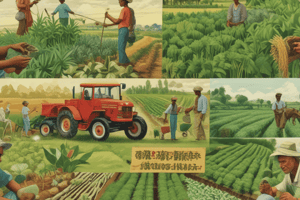Podcast
Questions and Answers
What was the consequence of using 'high yielding seeds' in India during the 1960s?
What was the consequence of using 'high yielding seeds' in India during the 1960s?
- Shift from wheat cultivation to maize cultivation
- Drastic increase in foodgrain production, known as the Green Revolution (correct)
- No significant impact on food production
- Decrease in foodgrain production due to lack of nutrients
Who is credited with the discovery of high-yielding wheat grains in the 1960s?
Who is credited with the discovery of high-yielding wheat grains in the 1960s?
- Dr. Norman Borlaug (correct)
- A German agricultural scientist
- Dr. M.S. Swaminathan
- An Indian government official
What problem did India face in 1965-66 that led to a severe scarcity of foodgrains?
What problem did India face in 1965-66 that led to a severe scarcity of foodgrains?
- Lack of interest in farming among the population
- Drastic drop in agricultural production due to severe drought (correct)
- Overabundance of food production causing storage issues
- Excessive use of chemical fertilizers leading to crop failure
What regions in India were initially chosen for the usage of high-yielding variety seeds of wheat?
What regions in India were initially chosen for the usage of high-yielding variety seeds of wheat?
What are some factors involved in growing crops using high-yielding grains?
What are some factors involved in growing crops using high-yielding grains?
What led to the immense increase in wheat production in Mexico and Taiwan?
What led to the immense increase in wheat production in Mexico and Taiwan?
Flashcards are hidden until you start studying





